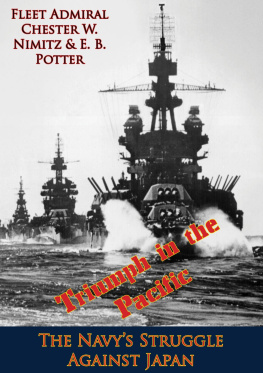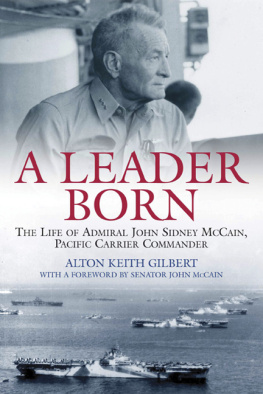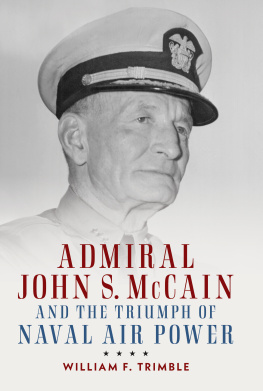
ADMIRAL
JOHN S. MCCAIN
AND THE TRIUMPH OF
NAVAL AIR POWER
Titles in the series:
Progressives in Navy Blue: Maritime Strategy, American Empire, and the Transformation of U.S. Naval Identity, 18731898
Learning War: The Evolution of Fighting Doctrine in the U.S. Navy, 18981945
Victory without Peace: The United States Navy in European Waters, 19191924
Studies in Naval History and Sea Power
Christopher M. Bell and James C. Bradford, editors
Studies in Naval History and Sea Power advances our understanding of sea power and its role in global security by publishing significant new scholarship on navies and naval affairs. The series presents specialists in naval history, as well as students of sea power, with works that cover the role of the worlds naval powers, from the ancient world to the navies and coast guards of today. The works in Studies in Naval History and Sea Power examine all aspects of navies and conflict at sea, including naval operations, strategy, and tactics, as well as the intersections of sea power and diplomacy, navies and technology, sea services and civilian societies, and the financing and administration of seagoing military forces.
ADMIRAL
JOHN S. MCCAIN
AND THE TRIUMPH OF
NAVAL AIR POWER
WILLIAM F. TRIMBLE
NAVAL INSTITUTE PRESS
ANNAPOLIS, MARYLAND
This book has been brought to publication with the generous assistance of Marguerite and Gerry Lenfest.
NAVAL INSTITUTE PRESS
291 Wood Road
Annapolis, MD 21402
2019 by William F. Trimble
All rights reserved. No part of this book may be reproduced or utilized in any form or by any means, electronic or mechanical, including photocopying and recording, or by any information storage and retrieval system, without permission in writing from the publisher.
Library of Congress Cataloging-in-Publication Data
Names: Trimble, William F., date, author.
Title: Admiral John S. McCain and the triumph of naval air power / William F. Trimble.
Description: Annapolis, MD : Naval Institute Press, [2019] | Series: Studies in naval history and sea power | Includes bibliographical references and index.
Identifiers: LCCN 2018042605 (print) | LCCN 2018043218 (ebook) | ISBN 9781682473719 (ePDF) | ISBN 9781682473719 (ePub) | ISBN 9781682473702 (hardcover) | ISBN 9781682473719 (ebook)
Subjects: LCSH: McCain, John Sidney, 18841945. | AdmiralsUnited StatesBiography. | United States. NavyOfficersBiography. | United States. NavyAviationHistory20th century. | Aircraft carriersUnited StatesHistory20th century. | World War, 19391945Pacific Area. | World War, 19391945Naval operations, American.
Classification: LCC E748.M1413 (ebook) | LCC E748.M1413 T75 2019 (print) | DDC 359.0092 [B] dc23
LC record available at https://lccn.loc.gov/2018042605
 Print editions meet the requirements of ANSI/NISO z39.48-1992
Print editions meet the requirements of ANSI/NISO z39.48-1992
(Permanence of Paper).
Printed in the United States of America.
27 26 25 24 23 22 21 20 199 8 7 6 5 4 3 2 1
First printing
All maps by Brad Sanders.
Book design and composition: Alcorn Publication Design
To Eleanor, Charlotte, and Clementine
CONTENTS
MAPS
ACKNOWLEDGMENTS
I n the long process of researching and writing this book, I assumed more debts than I can ever repay. Jim Bradford at Texas A&M University first suggested that I do something on John McCain, persuading me that after I wrote about Glenn Curtiss and the early pioneers of naval aviation it was time to look at someone like McCain, who was derided by early aviators as one of the Johnny-Come Latelys. With much trepidation I sent drafts of early chapters on McCain as commander, Aircraft South Pacific Force to John Lundstrom, the dean of naval air operations in the South Pacific in 1942. John, as well as James Sawruk, read the drafts and politely pointed out errors thathad I been more knowledgeable, experienced, and carefulI should have caught myself. Tom Wildenberg, my good friend and a superb naval historian, read most of the manuscript. His sharp editorial eye and admonitions to keep the focus on McCain vastly improved the finished product. At the Naval Academy, where I was the Class of 1957 Distinguished Chair of Naval Heritage for 20142015, my boss, Capt. C. C. Felker, helped me place McCain and the fast carrier task force in a wider strategic perspective, while colleagues Cdr. Davin OHora, Robert Love, and Jason Smith clarified my understanding of the Navys command structure and World War II in the Pacific. I also owe much to the expertise of Barbara Manvel at the Academys Nimitz Library, and Jennifer Bryan and David DOnofrio in the librarys Special Collections & Archives. Rick Russell, director of the Naval Institute Press, and Susan Todd Brook, senior acquisitions editor, offered encouragement and advice at times when I got distracted by other projects and responsibilities. The finished product owes much to the expert copy editing of Drew Bryan and the help of production editor Rachel Crawford.
I could not have written this and my other books without the services and holdings of the National Archives and Records Administration. At Archives II in College Park, Nathaniel Patch was unstinting in offering his time and expertise, which was essential for locating key Bureau of Aeronautics and Chief of Naval Operations files. He also made it possible for Auburn University to acquire Pacific Fleet message and dispatch files available only on microfilm. Eric Voelz at the National Personnel Records Center in St. Louis cut through the red tape to make a copy of McCains voluminous personnel file available to me. Over many years, no one has been more cordial and helpful than Jeff Flannery at the Manuscript Division of the Library of Congress. I am indebted to Dale Gordon, Tonya Simpson, and Curtis Utz at the Archives Branch of the Naval History and Heritage Command for making important collections available to me and other researchers after the NHHC came out of a prolonged period of reorganization. At the Naval War College, Douglas Smith and librarians Robin Lima, Dara Baker, and Dennis Zambrotta tracked down McCain materials that I otherwise might have overlooked. Hill Goodspeed and Marc Levitt at the National Naval Aviation Museum in Pensacola dug out the Thach Papers and other McCain-related materials for me. Carol Leadenham guided me to and through the McCain and other collections at the Hoover Institution Library and Archives at Stanford University. Brad Sanders somehow transformed my feeble penciled drafts into comprehensible maps and charts.
I cannot express enough praise for the encouragement and support from many colleagues and friends. In the History Department at Auburn University, former department chair Charles Israel carved out a semesters leave for me at a key point in the research and writing process. Morris Bian, Paul Casarona, Michael Kern, Angela Lakwete, and David Lucsko could not have been more helpful and supportive. Tim Dodge, Helen Goldman, and Dana Caudle in Auburns Ralph Brown Draughon Library were instrumental in acquiring and copying materials from Archives II. Fellow historian David Burke expertly removed imperfections from many of the books photos. Long-time friend and retired Air Force historian George Cully kept me on task by always asking me how much progress I had made on the McCain project. He also put me in touch with another retired Air Force historian, Daniel Harrington, whose work on Army Lt. Gen. Joseph T. McNarney led me to a crucial wartime agreement between the Army Air Forces and the Navy on the distribution of land-based strike aircraft. Tom Hughes at the School of Advanced Air and Space Studies at Maxwell Air Force Base and author of a superb biography of William Halsey allayed much of my anxiety about doing operational history. Over many years, my good friend Karen Babich opened her house on Chesapeake Bay to me on numerous trips to Washington.
Next page














 Print editions meet the requirements of ANSI/NISO z39.48-1992
Print editions meet the requirements of ANSI/NISO z39.48-1992